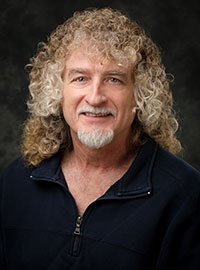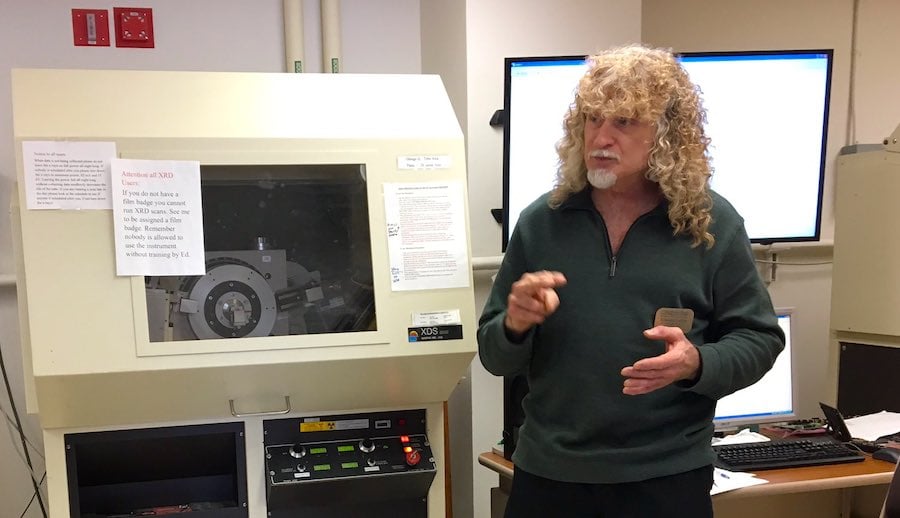
On Teaching Critical Thinking
Dr. Edward Laitila is a kind and humble science teacher who cannot be appreciated enough for his dedication to the advancement of science and the education of students. Over the years he has developed methods of analysis and processes for material development that are unique, practical, and yield powerful results. His way of teaching takes extra time to convey not only knowledge, but to impart skills in critical thinking that are too-often absent from a regular education. For his astounding work over many years, it is a pleasure to state just how valuable an asset he has been to Michigan Tech, to students, and to the scientific community.
Professor Laitila teaches courses in crystallography, diffraction, and materials forensics within the Materials Science and Engineering department. His official titles and positions are Senior Research Engineer/Scientist II and Adjunct Assistant Professor. His main duties are to act as the manager and sole employee of the X-Ray Facility, which operates under the Applied Chemical and Morphological Analysis Laboratory (ACMAL). There, he manages, operates and repairs the various X-Ray Diffraction (XRD) and X-Ray Fluorescence (XRF) equipment.
Research in X-Ray Diffraction
Dr. Laitila started running the X-Ray Facility in 1983. At that time he had a two-year electrical engineering degree. He then obtained a bachelor’s degree and spent the next 20 years researching and working. Eventually he found extra time to write a report on his years of research and to finish his PhD. He has many undergrad and graduate students doing research for him. He also teaches classes and helps students with planning their own research experiments and writing research papers. He now has nearly 40 years of experience in XRD.
XRD is a process of metrology which characterizes a material by measuring the size of, and pattern to, its atomic structure. X-rays are waves, and crystalline materials are made up of periodic arrangements of atoms in a crystal lattice structure. Every crystalline material has a pattern that is unique, referred to as a diffraction fingerprint. XRD involves wave behavior similar to light diffraction, such as that seen in the double slit experiment. The x-ray waves travel through spacing and can constructively or destructively interfere with each other, which results in the unique pattern. This produces a pattern of peaks and dark sections which can be analyzed to determine the material structure and the distance between the atoms themselves. Through XRD researchers can obtain pinpoint accuracy of a material’s lattice structure, chemical composition, and phase composition.
Recent Breakthroughs
Dr. Laitila’s research interests are X-ray diffraction theory and its many applications, including mechanical alloying, intermetallic materials, physical metallurgy, nanoscale materials, materials characterization, additive manufacturing, and powder metallurgy. His latest published research was featured in the journal Powder Diffraction, Vol. 23, Issue 2 and was entitled “Employing X-ray scattering to characterize materials with grain sizes in the nano-regime.” In it he explained his creation of a new analytical technique for measuring the number of atoms in the grain boundaries of a nanoscale material. He was chosen for publishing after giving a talk at an annual X-Ray powder diffraction conference. On that work, he remarked, “Even though I did it on one material, I showed that this could be applied to anything.” From that research he is now working on a process which can make iron directly from iron ore without a need for using carbon. Such a process is exciting because it could revolutionize the steel industry in a way that is net positive for earth’s climate.
In recent research Dr. Laitila has come up with a process for making nano-composites. With his novel method it is simple to vary the amount of a second phase by varying the milling time. He has dubbed it Mechanonanosynthesis. He explained that it will be ideal in the creation of powders for additive manufacturing.

Pioneering the Work
Dr. Laitila went into detail about some interesting projects he has done over the years. He explained that in 1983 the diffractometers were all analog machines, and that only a couple of types had been automated. The lab worked with a teletype, which put little holes on tape that would collect the data. Researchers would then put those in a mainframe computer to do analysis. He was asked in ‘84 if he could interface the diffractometer with an early-model PC, which had an 8088 processor. He used Basic to code an MS-DOS program for the interface. He laughed as he recalled the story, saying, “I got it to work, and got it to collect data, and then we bought an automated system.”
The professor describes himself as a big proponent of critical thinking. He explained, “I honestly believe we have got a major problem in our education system, because we teach knowledge instead of teaching how to think. Teachers here have critical thinking skills but we don’t usually focus on that. When a student comes to me with a question I try to return with a question that forces them to think of a way to answer their own question. Usually they have the knowledge but they don’t know how to piece it together. I try to piece things together from different subjects and how those things combine in material science. I try to take every opportunity to teach.” He explained that his favorite part of teaching is “seeing the light go on when a student gets the subject.”
Outreach in Materials
In addition to all his other duties, Dr. Laitila spends extra time teaching teenagers about science. He has run a session, as part of the Women in Engineering and Engineering Scholars program, for many years. Each summer for more than 50 years, Michigan Tech Summer Youth Programs (SYP) has welcomed to campus more than 1,000 youth from grades 6–11, from across the country and around the world. SYP students come for week-long, hands-on, experiential learning in one or more of their 50+ week-long explorations in science, technology, engineering, and mathematics (STEM), humanities, and law. Dr. Ed is a favorite among many students, especially those in the SYP. Last year, when students were finishing SYP and were asked what program was their favorite, they chanted Ed’s name.
Be the Catalyst
Dr. Edward Laitila is a catalyst for the process of science. He is a man that makes the magic happen. He is a student favorite, an expert in XRD, and a valuable researcher. Anyone interested in doing work with Edward or using the equipment in his lab should contact him or get in touch with ACMAL Director Elizabeth Miller for more information. Remote teaching and research are available. If you are a student with a project that requires XRD or are interested in helping Dr. Laitila with his research, there may be opportunities available to you.
There is no better place to get involved in some exciting research!
By Joshua Jongema.